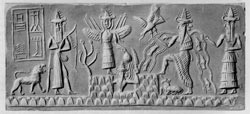Sumerian Anunnaki

Cylinder of Adda (Fg. 1-1)
Ancient Sumerian texts define the Anunnaki as "those who from heaven to Earth came" described as royal blood descending from the heavens and in certain contexts, the fallen angels or Nephilim. By comparative religions, it's believed the book of Genesis (600 BCE) was extrapolated from the Sumerian Epic of Creation believed to occur between 6000-8500 BCE. Records are also filled with great details of Anunnaki depicted as watchers, evident in later Biblical texts by Daniel and Jubilees. The ancient Sumerians sometimes described these deities as proprietors of mineral extractions from Earth, using the human race to replenish invaluable resources on the angel's home planet according to some researchers. Anunnaki were a heavenly council of seven, which may be interpreted as the first known written record referencing organized sons of god.
By historical accounts, the Anunnaki were the Gods & Goddesses who met occasionally in the heavens to indirectly determine the fate of mankind if by no fault of their own. Abraham's father Terah is considered as one who served the fallen angels, as the sons of the gods/goddesses, found in Psalms with reference to the Nephilim. Sharing part of the Babylonian creation myth as the children of Anu and Ki, the Anunnaki are associated with Earth's fate in Zecharia Sitchin's stories of Planet X (Nibiru, the 12th planet), and its return to over a long elliptical orbit. The Hopi tribe believe in a similar prophecy called the Blue Kachina, a time when the star people return to oversee a changing cycle of life on Earth.
When examining mysterious Anunnaki artifacts one might notice a unique resemblance to Egypt's interpretations of gods and goddesses. Angelic characteristics, the sun disc, and stories of the afterlife from the Book of the Dead hint strongly at an ancient Sumerian influence. Exactly how the Egyptians were in contact with the Sumerians, or which civilization was established first remains largely in debate. Archaeological evidence does propose both cultures may have coexisted during a period around 3,000 to 5,000 years ago by examining Mesopotamian temples and their distinct relation to Mastabas of the first and second Egyptian dynasties. There are several Egyptian artifacts which bare concepts of the Sumerian culture, yet there are also indications suggesting the possibility Egypt may have influenced Sumer during their state of unification. Historical time-lines show the Egyptians established foreign trade routes, secured precious stones, and designed sophisticated structures well before Sumerians. Yet, dating when the Sumerian epics took place establishes a time well before the settlement of Nineva 8,000 years ago by a culture who shares similar characteristics as both Egyptians and Sumerians, the Assyrians.
† Article 1-1
